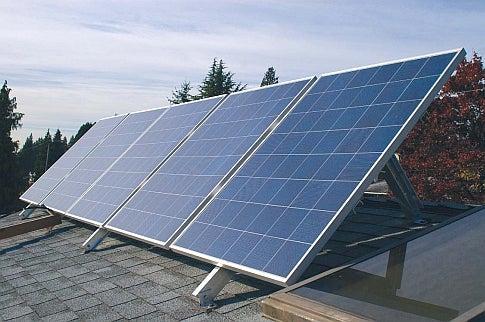EarthTalk: Going Solar
A buyer's guide to harnessing the energy of the sun

Dear EarthTalk: I am considering solar panels for my roof to provide heat for my hot water and possibly to do more than that. Are there some kinds of solar panels that are better than others? How do I find a knowledgeable installer? –Elise, Watertown, MA
What type of solar energy capture system you put on your home depends on your needs. If you want to go full tilt and generate usable electricity from your home’s rooftop—and even possibly contribute power back to the larger grid—tried and true photovoltaic arrays might be just the ticket. A typical installation involves the panels, which are constructed of many individual silicon-based photovoltaic cells and their support structures, along with an inverter, electrical conduit piping and AC/DC disconnect switches.
These systems can cost tens of thousands of dollars to install, and as such may not pencil out for those looking for the cheapest power solution. But the upside is that homeowners with photovoltaic panels on their rooftops can rest assured that as long as the sun shines, they will have power to spare without generating emissions of carbon dioxide and other noxious pollutants.
Qualified solar installers can usually advise clients on which specific types of systems will work best given the specific location of a home. U.S. homeowners can find qualified photovoltaic installers via the website FindSolar.com. And the North American Board of Certified Energy Practitioners (NABCEP) provides a free searchable database of its U.S. and Canadian members specializing in home solar set-ups.
For less demanding applications, such as for heating water for your home or swimming pool, a much simpler (and less expensive) solar thermal system might be all you need. A basic hot water system usually consists of a solar collector—basically a small metal box with a glass or plastic cover and a black copper or aluminum absorber plate inside—tied into the building’s plumbing and electrical works. According to the industry tracker website Solarbuzz, such solar collectors are usually mounted on rooftops.
Professional installers can get your home up and running with a solar thermal system for less than $4,000 in most cases. While the savings in your electric bill may be small, homeowners in it for the long haul will definitely save over time, all the while enjoying the fact that you have lowered your family’s carbon footprint significantly.
Homeowners looking to find out more about residential solar systems should be sure to check out the RealGoods Solar Living Sourcebook, a 600+ page renewable energy “bible” now in its 30th edition. The book features the latest nuts-and-bolts information on how to harvest renewable energy in a variety of ways depending on need. And RealGoods also sells much if not all of the equipment needed.
Another reason to consider going solar in one fashion or another is tax incentives. According to the Database of State Incentives for Renewables and Efficiency (DSIRE), 17 states now offer homeowners some kind of tax rebate or incentive for the purchase and/or installation of solar power equipment of any kind. You can see what if any your state offers by logging onto the dsireusa.org website, where the searchable database is available in its entirety for free.
GOT AN ENVIRONMENTAL QUESTION? Send it to: EarthTalk, c/o E – The Environmental Magazine, P.O. Box 5098, Westport, CT 06881 USA; submit it at: www.emagazine.com/earthtalk/thisweek; or email: earthtalk@emagazine.com. Read past columns at: www.emagazine.com/earthtalk/archives.php.